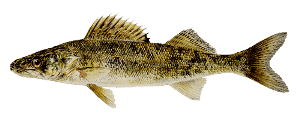Characteristics

Walleyes spawn in 1 to 6 feet of water over rocks and gravel usually in rivers where the current clears away any debris. The male tends to move into the spawning areas in early spring when the temperature is slightly above freezing. The female arrives shortly thereafter. Spawning occurs when the water temperature ranges from 42 – 50 degrees. A larger female can deposit about 100,000 eggs. The male will then fertilize the eggs. After eggs are laid and fertilized the female and male leave the area so the eggs can hatch.
Habitat
Walleyes live in large, shallow, windswept lakes, as well as rivers and streams with gravel beds. They are considered game and food fish and live in thousands of lakes. Because of their low-light vision and sensitivity to light it plays into their behavior. They usually go into shallow water at dawn and dusk to feed. Since they are fish-eaters, they mostly eat yellow perch, which can’t see very well at night making them an easy prey. During daylight, they tend to move into shallow areas that are heavily weeded containing many boulders and logs. They will also seek cover in deeper water. They become more active in the day if the water is choppy or if it’s cloudy because the water does not have the glare of the sun making it easier for them to see.
After spawning, they move into their feeding areas. Since they are a cool-water fish they spend most of the summer in deeper water. As these fish-eating fish become larger they will spend less time hunting for food and spend more time in deeper water.
Equipment
Some anglers may believe this fish can be a finicky fish because they don’t always respond to daylight fishing unless you are fishing in an area where they hang out. It is recommended that light to medium action rods and reels be used along with 8 pound test line. It’s best to use live minnows, leeches or any lure that resembles a fish since they are fish-eating fish. Depending on the clarity of the water you can use chartreuse colored lures because they resemble a fish.
Tips for Fishing
Walleyes have sharp teeth so I recommend that you be careful when handling them. Some anglers use protective gloves. If you are fishing for them and find their environment, be prepared to work at it because they will be aggressive when hooked. Before dawn, night time or cloudy days are good fishing times to catch this fish. This fish was designed to be more of a night feeder to offset how other fish eat.
Jigging with minnows or leeches are a good way to fish for them. If using a lead head and adding a minnow or leech to it, it is recommended that you try using a red, blue, or purple lead heads as these colors tend to attract them.
As noted above, their behavior determines how they respond to the baits or lures you are using. So be prepared to change the way you fish as one way may be more productive than another.
It is recommended that you practice Catch N’ Release as this will help in the protection and existence of these fish.
The DNR is always working on the protection of fish habitat and maintaining a good balance of fish and lake environment in an effort to keep fish well for anglers.

